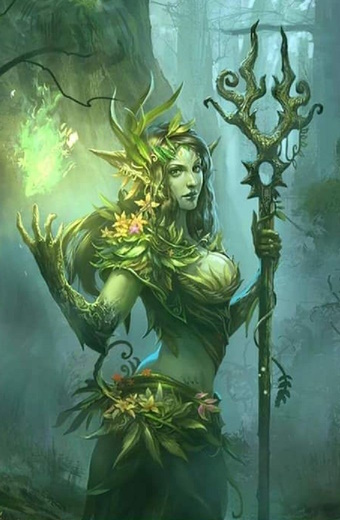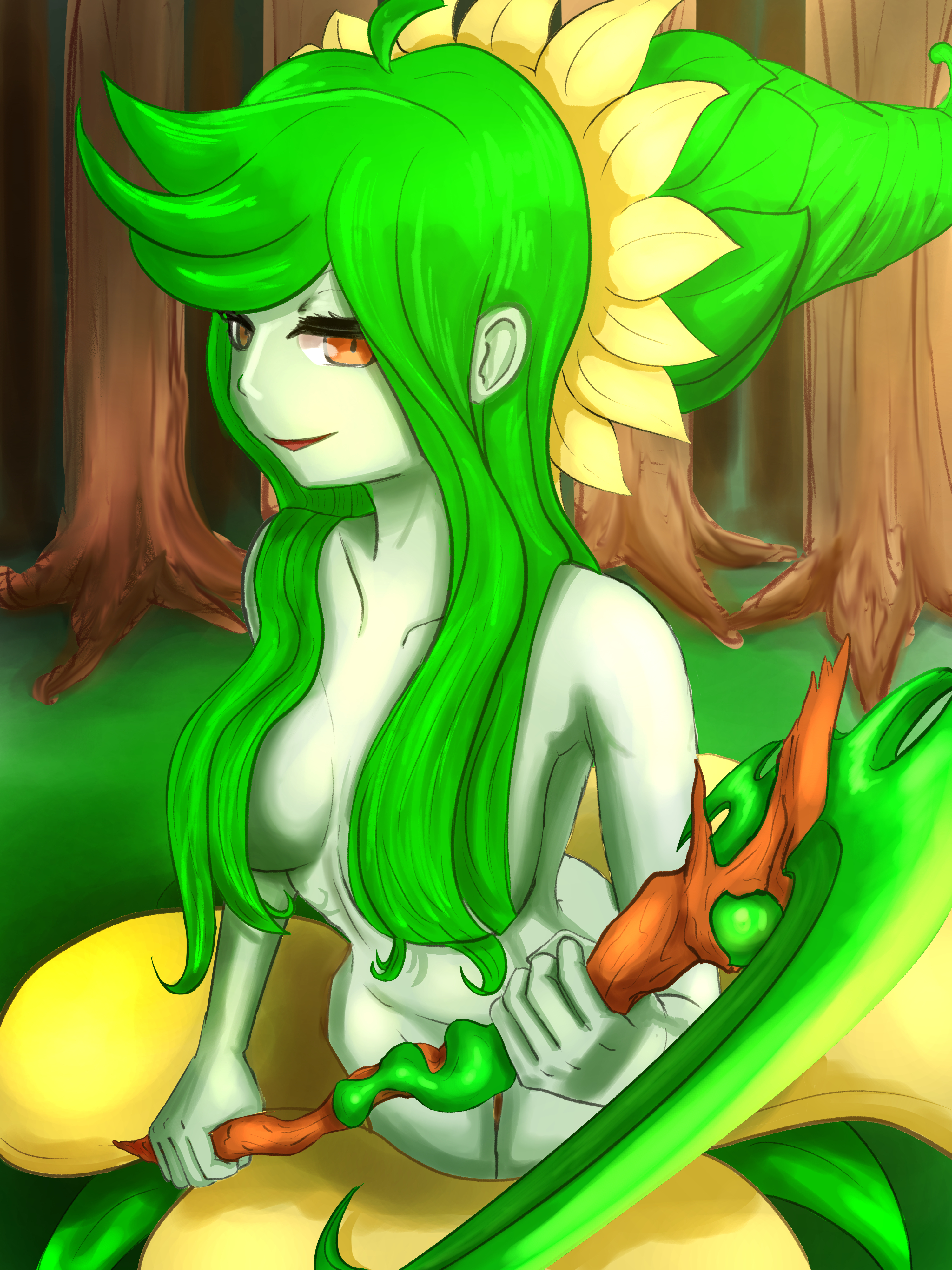Forest Nymph
Average Physique
While lower half is a thick stem, the upper half is of humanoid shape. They have been described to have a feminine form by many accounts, however they lack certain features such as a belly button and any signs of a bone structure - their back instead showing a "spine" which is composed of a harder plant matter, similar to a leaf's midrib. Their chest is flat, but human accounts have stated otherwise.Basic Information
Anatomy
Despite the humanoid upper-half, Forest Nymphs are composed of 100% plant and 0% flesh; as opposed to a 50/50 split. They have no internal organs besides a mouth - mainly used for increased water intake, a faster alternative to absorbing. They can talk without vocal cords and see without real eyes using their soul. Giant flower petals grow from and encircle their hips, taking colours and petal shapes similar to the surrounding flora of their birth.
Below the waist, their body transitions into a thick plant stem which splits into many smaller roots at the bottom; some nymphs have prickles on their stems and roots. Roots commonly branch out from the main stem above the splitting point. These roots have two purposes, movement and defense. Forest Nymphs move similarly to an octopus on land, or a Living Bloom - shifting their roots on the ground. All roots are controllable, and beneficial to protecting their main stem - their weakest point. The many roots can create a thicket to shield their stem.
Genetics and Reproduction
In the Spring season, Forest Nymphs begin producing seeds from the base of their main stem, which stick onto the underside of their flower petals. An enchanted pond is required for the seeds to grow, which the nymph creates naturally by simply floating in the pond for a long duration. To plant the seeds, the nymph moves to the pond's edge and twirls their body side-to-side, shaking off the seeds from their petals.
During seed production and growth, Forest Nymphs become extremely aggressive. This is due to the fact that it takes roughly 200 years for a Forest Nymph to fully blossom from their seed, and they only produce more seeds once every decade; thus the bulbs grown from the seeds need to be protected.
All nymphs are considered female by others due to their humanoid form's appearance. However, they themselves are asexual and have no interest in self-classification.
Growth Rate & Stages
It takes roughly 5 years for a nymph's seed to grow into a bulb, and a further 150 to sprout from it a nymph. They aren't yet ready once sprouted, remaining attached to the bulb for another 50 years. A fully blossomed nymph absorbs the bulb that once contained it and begins normal life.
Ecology and Habitats
Forest Nymphs live in large forests, far from human civilization. They usually reside in hollowed-out great oaks next to a pond or body of water. Few don't have a great oak to live in, but have a pond. Ponds are vital for reproduction so they never live far from one.
Dietary Needs and Habits
Photosynthesis.
Additional Information
Facial characteristics
They have a nose, mouth, and eyes. The eyes are not connected to any brain, instead they are connected to the soul for vision - strong enough souls are capable of creating fake eyes, a common example being skeletons with white dots in their eye sockets. Their irises can range from an orange, pink, green, or blue colour.
Their hair is composed of a fine plant fiber and can range in greens of dark and light. Rarely, they can have different colours depending on their origin - for example, nymphs of the Silverwood Forest may have silver or golden hair.
Geographic Origin and Distribution
Anglon
Average Intelligence
They have high intelligence and learn through observation. Forest Nymphs are able to learn human languages if enough humans have come into contact, otherwise they are silent.
They are territorial and solitary beings, only allowing company if no ill intentions are perceived. Nymphs are rarely seen in groups or couples, unless one had recently blossomed and is living with their parent, but that has never been witnessed before.
Perception and Sensory Capabilities
Forest Nymphs have human vision, seeing colours and far distances. They all have the innate magic of nature, which can allow them to control plants and roots, wood and bark. What may be the most interesting ability is their communication with the world itself. With meditation, they are able to call upon Epidotra and speak to it; this grants insight beyond human limits, which can be used to figure out a creature's true intentions or to be alerted of dangers - natural and unnatural - that besiege the earth. This communication with Epidotra may be a hint of their origins, which has yet to be uncovered.
Civilization and Culture
Common Myths and Legends
The origins of Forest Nymphs are unknown and speculated upon greatly. The most agreed upon idea is they were created by Epidotra itself naturally, blooming from the earth many millennia ago. Other myths of the more prideful say they were created by nature to mimic the perfect form of humans.
As humanity seldom witnesses Forest Nymphs, and those that have were only able to take a glance before being chased off, they have an inaccurate portrayal of their appearance. Artistic depictions show them having a much more human appearance than what is accurate. The mystery and intrigue of these nymphs have generated assumptions of how they act and their culture, creating a fictional figure known as Nyssa, the Forest Nymph Queen - which is based on the idea that the nymphs have some sort of hierarchy, which is false.
Lifespan
5,000 years
Average Height
Ground to Waist - 4.5ft
Waist to Head - 3ft
Total - 7.5ft
Body Tint, Colouring and Marking
They have pale green skin composed of plant matter.
Related Organizations
Discovered by




Comments